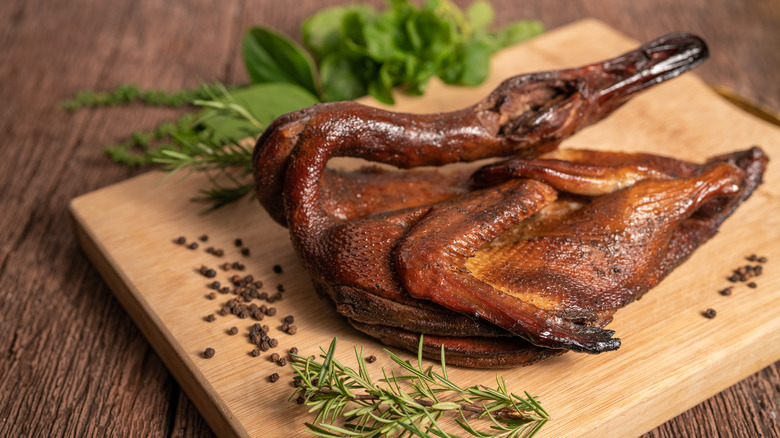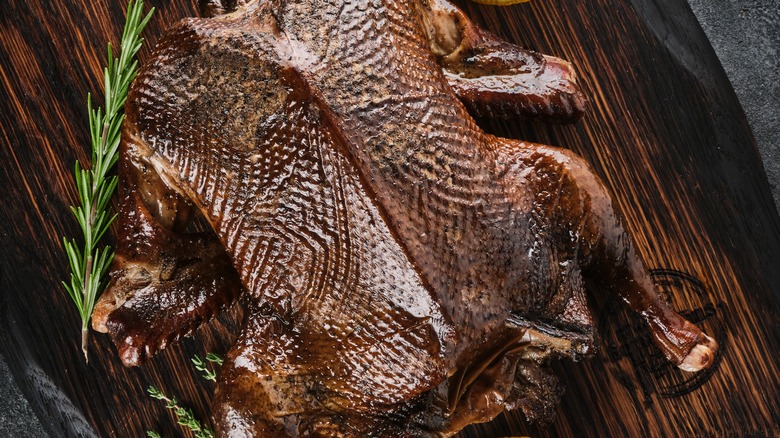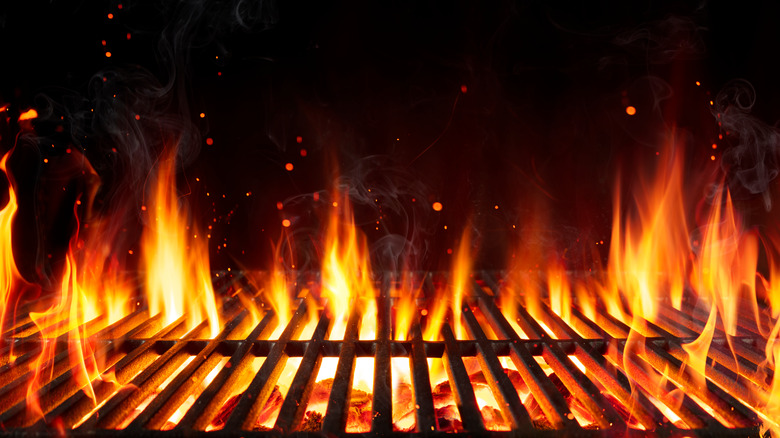2 Simple Methods For Crispier Skin On Smoked Duck
Side dishes can be translated in different ways — cornbread stuffing instead of sourdough, baked sweet potatoes rather than candied, but often mains seem set. Roasted turkey, glazed ham, and carved prime rib hold court on the holiday table. That is not to say, though, that with a little outside-the-box thinking, a Christmas meal can't straddle the line between traditional and unconventional.
Take duck, for instance. It's fowl, like turkey, but it has a singular flavor and richness that make it an ideal treat for a holiday meal. While it is wonderful roasted, duck takes to a variety of preparations. Among them is smoking, which imparts the duck with a heady aroma that matches its assertive flavor and renders the bird's considerable fat, keeping the lean meat juicy. Smoking has its drawbacks, though, chief among them being that the low and slow method can leave the skin of duck (and other poultry) limp and unpleasant. But a few simple tricks can help punch up that skin to crispy perfection.
Secrets of smoking
At first glance, ducks seem to have little in common with pigs and salmon. But in culinary terms, they all share an important trait that informs how they are cooked: they are fatty. Pork, duck, and salmon flesh are prized for their luscious and pronounced flavor, which is also, as Hunter Angler Gardener Cook points out, why you frequently see them smoked. The same fat that carries the unique flavor of the animal so well, also absorbs and delivers the flavor of smoke.
Smoking duck is a pretty straightforward affair for those familiar with the basics. It doesn't require a specialized smoker, as a simple kettle grill will suffice. The Online Grill offers a few tips to ensure an optimal end product. First, as with all meats, season thoroughly with salt (at the very least), and allow it to rest uncovered in the fridge for several hours. This allows the salt to penetrate the meat, and dries the exterior to promote browning and crisping. Before smoking, allow the duck to return to room temperature to ensure an even cook. Remember smoking is done at low temperatures, and duck is no exception. Aim for around 225 degrees Fahrenheit. Finally, make sure you pierce the skin — especially of farm-raised ducks — to allow the rendering fat to escape, and place the duck over a drip pan to catch the fat before it hits the fire and burns.
Turn up the heat
After the duck is done smoking and has an internal temperature around 165 degrees, it is ready to come off the heat. But the problem stands as to what to do with the skin, which can still look a bit wan at this point. The trick to a crackling crisp skin is (again) heat, but there are a couple of different ways to get what you're looking for.
The most obvious choice is the grill, which might be what you just took the duck off of. The Spruce Eats advises that you crank up the grill to high heat while the duck rests. If you have a propane grill, simply turn the gas all the way up. If you are using charcoal, the Barbecue Bible says to open the vents fully will allow for maximum airflow and thus hotter coals. Once you have the heat you need, The Spruce Eats says to put the duck on the grill but to exercise caution, as a little heat goes a long way. Frequently move the duck to crisp the skin up without burning it or overcooking the meat underneath. And if this method seems a bit too labor-intensive or tricky to pull off, just head into the kitchen, as the same result can be achieved by broiling the duck for 15 minutes at 500 degrees.


